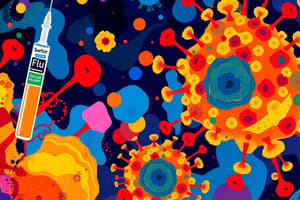Podcast
Questions and Answers
What are the typical months of flu season in the Northern Hemisphere?
What are the typical months of flu season in the Northern Hemisphere?
October through May
When does flu activity usually peak?
When does flu activity usually peak?
- December (correct)
- February (correct)
- October
- April
Influenza C causes severe symptoms.
Influenza C causes severe symptoms.
False (B)
What condition increases the risk for severe illness from the flu?
What condition increases the risk for severe illness from the flu?
What is one common symptom of the flu?
What is one common symptom of the flu?
How does the flu primarily spread?
How does the flu primarily spread?
The flu vaccine needs to be administered only once in a lifetime.
The flu vaccine needs to be administered only once in a lifetime.
What is a recommended treatment method for flu symptoms?
What is a recommended treatment method for flu symptoms?
Which group has the highest rates of severe illness from the flu?
Which group has the highest rates of severe illness from the flu?
The illness caused by the influenza virus is commonly known as the ______.
The illness caused by the influenza virus is commonly known as the ______.
Match the following flu treatment strategies with their descriptions:
Match the following flu treatment strategies with their descriptions:
Flashcards are hidden until you start studying
Study Notes
Flu Season
- Seasonal influenza viruses are predominantly active in fall and winter in the U.S., typically increasing in October.
- Peak flu activity usually occurs between December and February, although it can last until May.
- Post-COVID pandemic, flu activity timing and duration have become less predictable.
- Historically, peak flu activity occurred most often in February (17 seasons), followed by December (7), January (6), and March (6), over a 40-year period.
Understanding Influenza
- The flu, caused by the influenza virus, leads to symptoms such as fever, body aches, sore throat, and respiratory issues.
- Influenza is more common in winter months, leading to potential epidemics.
- Flu season lasts from October to May in the Northern Hemisphere, with peak cases typically in December through February.
Flu vs. Common Cold
- Flu symptoms are often more severe than common cold symptoms, which are typically mild.
- The flu and cold are caused by different viruses.
High-Risk Groups
- Individuals more susceptible to severe illness include those with chronic respiratory diseases, cardiovascular diseases, diabetes, weakened immune systems, and certain age groups (under 5 or over 65).
- Non-Hispanic Black, American Indian, and Hispanic populations report higher rates of severe flu illness compared to their non-Hispanic White and Asian counterparts.
Flu Symptoms
- Rapid onset of symptoms can include: fever, chills, body aches, cough, headache, sore throat, and fatigue.
- Diarrhea or vomiting may occur in children.
Influenza Virus Overview
- Types A, B, and C cause influenza in humans, with A and B being seasonal and more severe.
- H1N1 (swine flu) and bird flu are subtypes of influenza A.
- Contagious nature: One infected person can spread the virus to one or two additional people.
Transmission
- The flu spreads through coughs, sneezes, or talking, releasing droplets that can be inhaled or come into contact with surfaces.
- Infection can also occur by touching contaminated surfaces and then touching the face.
Treatment Options
- Antiviral medications may be prescribed if symptoms appear within 48 hours or if the individual is at higher risk for complications.
- Home remedies may include rest, hydration, over-the-counter medications for symptom relief, and decongestants.
Preventive Measures
- Annual flu vaccination is crucial as it helps the immune system combat the virus.
- Practice good hygiene: regular handwashing, covering sneezes/coughs, and avoiding close contact with sick individuals.
- Sanitizing high-touch areas in shared spaces is essential.
Caregiver Responsibilities
- Family caregivers should ensure seniors are vaccinated to lower flu hospitalization risks.
- Regular sanitation of living spaces and personal hygiene practices are key components of prevention.
- Prompt medical care should be sought when seniors exhibit flu symptoms to prevent complications.
Preparation and Stocking Supplies
- Caregivers should maintain a well-stocked supply of over-the-counter medications, sanitizers, and tissues.
- Proactive stocking allows for quick responses during flu season, minimizing virus spread.
Support for Senior Care
- Family caregivers play a vital role in protecting seniors during flu season by promoting vaccinations, cleanliness, personal hygiene, early symptom recognition, and preparedness for health challenges.
Studying That Suits You
Use AI to generate personalized quizzes and flashcards to suit your learning preferences.




